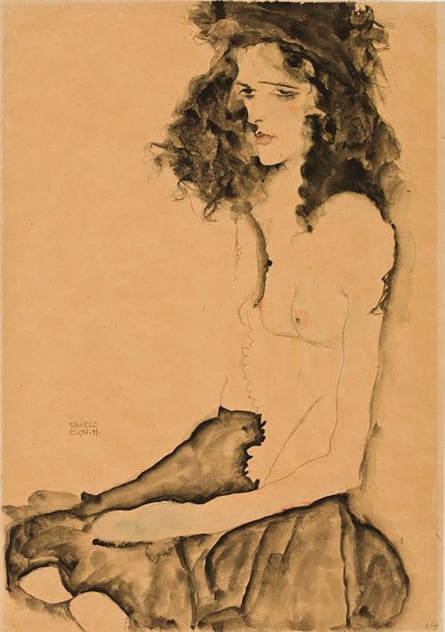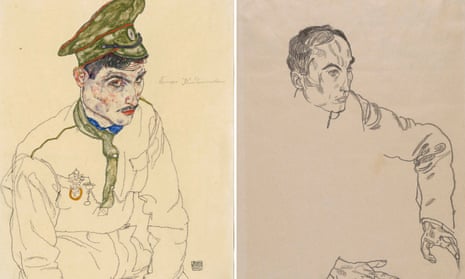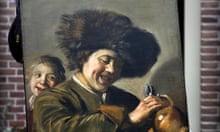Three artworks believed stolen during the Holocaust from a Jewish art collector and entertainer have been seized from museums in three different states by New York law enforcement authorities.
The artworks by the Austrian expressionist Egon Schiele were previously owned by Fritz Grünbaum, a cabaret performer and songwriter who died at the Dachau concentration camp in 1941.
The art was seized on Wednesday from the Art Institute of Chicago, the Carnegie Museums of Pittsburgh and the Allen Memorial Art Museum at Oberlin College in Ohio.
Warrants issued by the office of the Manhattan district attorney, Alvin Bragg, say there is reasonable cause to believe the three artworks are stolen property.
The three works, and others from the collection, which Grünbaum began assembling in the 1920s, are already the subject of civil litigation on behalf of his heirs. They believe the entertainer was forced to cede ownership of his artworks under duress.
Manhattan prosecutors believe they have jurisdiction in all of the cases because the artworks were bought and sold by Manhattan art dealers at some point.
The son of a Jewish art dealer in what was then Moravia, Grünbaum studied law but began performing in cabarets in Vienna in 1906.
A well-known performer in Vienna and Berlin by the time Adolf Hitler rose to power, Grünbaum challenged the Nazi authorities in his work. He once quipped from a darkened stage, “I can’t see a thing, not a single thing; I must have stumbled into national socialist culture.”
Grünbaum was arrested and sent to Dachau in 1938. He gave his final performance for fellow inmates on New Year’s Eve 1940 while gravely ill, and died on 14 January 1941.
The three pieces seized by Bragg’s office are Russian War Prisoner, a watercolour and pencil-on-paper piece valued at $1.25m (£1m), which was seized from the Art Institute; Portrait of a Man, a pencil-on-paper drawing valued at $1m and seized from the Carnegie; and Girl With Black Hair, a watercolour and pencil-on-paper work valued at $1.5m and taken from Oberlin.

The works will remain at the museums until they can be transported to the district attorney’s office.
The Art Institute said in a statement on Thursday: “We are confident in our legal acquisition and lawful possession of this work. The piece is the subject of civil litigation in federal court, where this dispute is being properly litigated and where we are also defending our legal ownership.”
The Carnegie said it was committed to “acting in accordance with ethical, legal, and professional requirements and norms” and would cooperate with the authorities.
In a statement, Oberlin said it was cooperating with investigators and was “confident that Oberlin College legally acquired Egon Schiele’s Girl with Black Hair in 1958, and that we lawfully possess it”.
“We believe that Oberlin is not the target of the Manhattan DA’s criminal investigation into this matter,” the statement added.
Before the warrants were issued, Grünbaum’s heirs had filed civil claims against the three museums and several other defendants seeking the return of artworks they say were looted from Grünbaum.
They won a victory in 2018 when a New York judge ruled that two works by Schiele had to be turned over to Grünbaum’s heirs under the Holocaust Expropriated Recovery Act, passed by Congress in 2016.
In that case, the attorney for the London art dealer Richard Nagy said Nagy was the rightful owner of the works because Grünbaum’s sister-in-law, Mathilde Lukacs, had sold them after his death. But Judge Charles Ramos ruled that there was no evidence that Grünbaum had voluntarily transferred the artworks to Lukacs.
“A signature at gunpoint cannot lead to a valid conveyance,” he wrote.
Raymond Dowd, the attorney for the heirs in their civil proceedings, referred questions about the seizure of the three works on Wednesday to the district attorney’s office.
The actions taken by Bragg’s office follow the seizures of what investigators said were looted antiquities from museums in Cleveland and Worcester, Massachusetts.
Douglas Cohen, a spokesperson for the district attorney, said he could not comment on the artworks seized except to say that they were part of an ongoing investigation.









